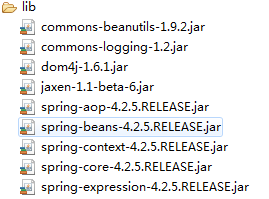概述
上文我们已经学会使用@Resource注解注入属性。学是学会了,但也仅限于会使用而已,故我们要深入剖析其内部原理,才算真正明白。接下来我们就来编码剖析@Resource注解的实现原理,但这都是建立在用@Resource注解完成属性装配的案例基础上的。
由于我们要使用dom4j工具来读取Sping的配置文件——beans.xml,所以需要将dom4j所需的jar包导入项目中。dom4j所需的jar包为:
- dom4j-1.6.1.jar
- jaxen-1.1-beta-6.jar
使用dom4j工具读取到诸如
<bean id="personService" class="cn.itcast.service.impl.PersonServiceBean">
...
</bean>这样的内容时,务必需要将读取到的bean的信息存到一个JavaBean对象中。于是我们可在junit.test包下创建这样一个JavaBean——BeanDefinition.Java,其代码为:
/**
* 将读取到的bean的信息存到一个JavaBean对象中
* @author li ayun
*
*/
public class BeanDefinition {
private String id;
private String className;
private List<PropertyDefinition> propertys = new ArrayList<PropertyDefinition>();
public BeanDefinition(String id, String className) {
this.id = id;
this.className = className;
}
public String getId() {
return id;
}
public void setId(String id) {
this.id = id;
}
public String getClassName() {
return className;
}
public void setClassName(String className) {
this.className = className;
}
public List<PropertyDefinition> getPropertys() {
return propertys;
}
public void setPropertys(List<PropertyDefinition> propertys) {
this.propertys = propertys;
}
}接着,我们还要在junit.test包下新建一个JavaBean——PropertyDefinition.java,该JavaBean专门用于存放<property ...>的信息,其代码如下:
/**
* 该JavaBean专门用户存放<property>的信息
* @author li ayun
*
*/
public class PropertyDefinition {
private String name;
private String ref;
private String value;
public String getValue() {
return value;
}
public void setValue(String value) {
this.value = value;
}
public PropertyDefinition(String name, String ref, String value) {
this.name = name;
this.ref = ref;
this.value = value;
}
public String getName() {
return name;
}
public void setName(String name) {
this.name = name;
}
public String getRef() {
return ref;
}
public void setRef(String ref) {
this.ref = ref;
}
}我们模拟Spring容器注入基本类型属性时,须将本身为字符串的值转成相应的属性类型的值,所以就要用到commons-beanutils工具,即要将commons-beanutils-1.9.2.jar包导入到项目中去。这样,项目中共须jar包有:

接下来,我们在junit.test包中新建一个注解类——ItcastResource.java,其代码如下:
@Retention(RetentionPolicy.RUNTIME)
@Target({ElementType.FIELD, ElementType.METHOD})
public @interface ItcastResource {
public String name() default "";
}以上所有事情做好之后,我们就要对传智播客版的Spring容器修修改改了,即将ItcastClassPathXMLApplicationContext类的代码修改为:
/**
* 传智播客版Spring容器
* @author li ayun
*
*/
public class ItcastClassPathXMLApplicationContext {
private List<BeanDefinition> beanDefines = new ArrayList<BeanDefinition>();
private Map<String, Object> sigletons = new HashMap<String, Object>();
public ItcastClassPathXMLApplicationContext(String filename) {
this.readXML(filename);
this.instanceBeans();
this.injectObject();
this.annotationInject();
}
private void annotationInject() {
for (String beanName : sigletons.keySet()) {
Object bean = sigletons.get(beanName);
if (bean != null) {
try {
PropertyDescriptor[] ps = Introspector.getBeanInfo(bean.getClass()).getPropertyDescriptors();
for (PropertyDescriptor propertyDesc : ps) {
Method setter = propertyDesc.getWriteMethod(); // 获取属性的setter方法
if (setter != null && setter.isAnnotationPresent(ItcastResource.class)) { // setter方法存在注解
ItcastResource resource = setter.getAnnotation(ItcastResource.class);
Object value = null;
if (resource.name() != null && !"".equals(resource.name())) { // 指定了注解的name属性
value = sigletons.get(resource.name());
} else {
value = sigletons.get(propertyDesc.getName());
if (value == null) {
for (String key : sigletons.keySet()) {
// isAssignableFrom(xxx)方法判断propertyDesc.getPropertyType()获得的类型是否是xxx的接口或父类,或者是xxx本身
if (propertyDesc.getPropertyType().isAssignableFrom(sigletons.get(key).getClass())) {
value = sigletons.get(key);
break;
}
}
}
}
setter.setAccessible(true); // 允许访问私有的setter方法
setter.invoke(bean, value); // 把引用对象注入到属性中
}
}
Field[] fields = bean.getClass().getDeclaredFields();
for (Field field : fields) {
if (field.isAnnotationPresent(ItcastResource.class)) {
ItcastResource resource = field.getAnnotation(ItcastResource.class);
Object value = null;
if (resource.name() != null && !"".equals(resource.name())) { // 指定了注解的name属性
value = sigletons.get(resource.name());
} else {
value = sigletons.get(field.getName());
if (value == null) {
for (String key : sigletons.keySet()) {
// isAssignableFrom(xxx)方法判断field.getPropertyType()获得的类型是否是xxx的接口或父类,或者是xxx本身
if (field.getType().isAssignableFrom(sigletons.get(key).getClass())) {
value = sigletons.get(key);
break;
}
}
}
}
field.setAccessible(true); // 允许访问private字段
field.set(bean, value);
}
}
} catch (Exception e) {
e.printStackTrace();
}
}
}
}
/**
* 为bean对象的属性(依赖)注入值
*/
private void injectObject() {
for (BeanDefinition beanDefinition : beanDefines) {
Object bean = sigletons.get(beanDefinition.getId());
if (bean != null) {
try {
PropertyDescriptor[] ps = Introspector.getBeanInfo(bean.getClass()).getPropertyDescriptors();
for (PropertyDefinition propertyDefinition : beanDefinition.getPropertys()) {
for (PropertyDescriptor propertyDesc : ps) {
if (propertyDefinition.getName().equals(propertyDesc.getName())) {
Method setter = propertyDesc.getWriteMethod(); // 获取属性的setter方法,private
if (setter != null) { // 最好判断有无setter方法,因为属性可以没有setter方法
/*
Object value = sigletons.get(propertyDefinition.getRef());
setter.setAccessible(true); // 允许访问私有的setter方法
setter.invoke(bean, value); // 把引用对象注入到属性中
*/
Object value = null;
if (propertyDefinition.getRef() != null && !"".equals(propertyDefinition.getRef().trim()) ) {
value = sigletons.get(propertyDefinition.getRef());
} else { // 注入基本类型
value = ConvertUtils.convert(propertyDefinition.getValue(), propertyDesc.getPropertyType()); // 把本身为字符串的值转成相应的属性类型的值
}
setter.setAccessible(true); // 允许访问私有的setter方法
setter.invoke(bean, value); // 把引用对象注入到属性中
}
break;
}
}
}
} catch (Exception e) {
e.printStackTrace();
}
}
}
}
/**
* 完成bean的实例化
*/
private void instanceBeans() {
for (BeanDefinition beanDefinition : beanDefines) {
try {
if (beanDefinition.getClassName() != null && !"".equals(beanDefinition.getClassName().trim())) {
sigletons.put(beanDefinition.getId(), Class.forName(beanDefinition.getClassName()).newInstance());
}
} catch (Exception e) {
e.printStackTrace();
}
}
}
/**
* 读取xml配置文件
* @param filename
*/
private void readXML(String filename) {
SAXReader saxReader = new SAXReader();
Document document = null;
try {
URL xmlpath = this.getClass().getClassLoader().getResource(filename);
document = saxReader.read(xmlpath);
Map<String, String> nsMap = new HashMap<String, String>();
nsMap.put("ns", "http://www.springframework.org/schema/beans");// 加入命名空间
XPath xsub = document.createXPath("//ns:beans/ns:bean");// 创建beans/bean查询路径
xsub.setNamespaceURIs(nsMap);// 设置命名空间
List<Element> beans = xsub.selectNodes(document);// 获取文档下所有bean节点
for (Element element : beans) {
String id = element.attributeValue("id");// 获取id属性值
String clazz = element.attributeValue("class"); // 获取class属性值
BeanDefinition beanDefine = new BeanDefinition(id, clazz);
XPath propertysub = element.createXPath("ns:property");
propertysub.setNamespaceURIs(nsMap); // 设置命名空间
List<Element> propertys = propertysub.selectNodes(element);
for (Element property : propertys) {
String propertyName = property.attributeValue("name");
String propertyRef = property.attributeValue("ref");
// System.out.println(propertyName + "=" + propertyRef);
String propertyValue= property.attributeValue("value");
PropertyDefinition propertyDefinition = new PropertyDefinition(propertyName, propertyRef, propertyValue);
beanDefine.getPropertys().add(propertyDefinition);
}
beanDefines.add(beanDefine);
}
} catch (Exception e) {
e.printStackTrace();
}
}
/**
* 获取bean实例
* @param beanName
* @return
*/
public Object getBean(String beanName) {
return this.sigletons.get(beanName);
}
}传智播客版Spring容器写好之后,我们就要试验一把了。首先将@ItcastResource注解使用在属性的setter方法上,如将PersonServiceBean类的代码修改为:
public class PersonServiceBean implements PersonService {
private PersonDao personDao;
private String name;
@ItcastResource
public void setPersonDao(PersonDao personDao) {
this.personDao = personDao;
}
public PersonServiceBean() {}
public PersonServiceBean(PersonDao personDao, String name) {
this.personDao = personDao;
this.name = name;
}
@Override
public void save() {
// System.out.println(name);
personDao.add();
}
}接着我们将单元测试类——SpringTest.java的代码修改为:
public class SpringTest {
@Test
public void instanceSpring() {
ItcastClassPathXMLApplicationContext ctx = new ItcastClassPathXMLApplicationContext("beans.xml");
PersonService personService = (PersonService) ctx.getBean("personService");
personService.save();
}
}测试instanceSpring()方法,可看到Eclipse控制台打印:

当然了,我们也可将@ItcastResource注解用在字段上,如将PersonServiceBean类的代码修改为:
public class PersonServiceBean implements PersonService {
@ItcastResource private PersonDao personDao;
private String name;
public void setPersonDao(PersonDao personDao) {
this.personDao = personDao;
}
public PersonServiceBean() {}
public PersonServiceBean(PersonDao personDao, String name) {
this.personDao = personDao;
this.name = name;
}
@Override
public void save() {
// System.out.println(name);
personDao.add();
}
}再次测试instanceSpring()方法,仍可看到Eclipse控制台打印:

如要查看源码,可点击编码剖析@Resource注解的实现原理进行下载。
最后
以上就是稳重自行车为你收集整理的编码剖析@Resource注解的实现原理的全部内容,希望文章能够帮你解决编码剖析@Resource注解的实现原理所遇到的程序开发问题。
如果觉得靠谱客网站的内容还不错,欢迎将靠谱客网站推荐给程序员好友。








发表评论 取消回复